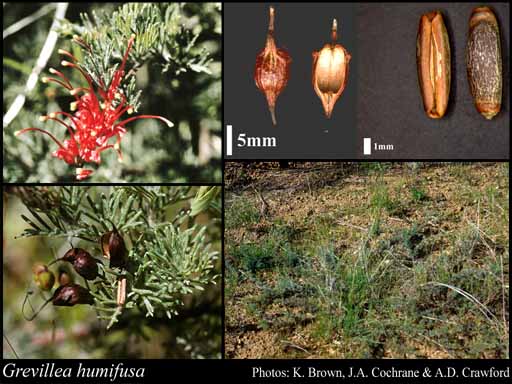- Reference
- Grevillea 1:182 (1994)
- Conservation Code
-
Threatened
A taxon name retains its ‘Threatened’ status until a new name has been officially endorsed and appears in the Gazettal Notice.
- Naturalised Status
- Native to Western Australia
- Name Status
- Current
Prostrate to decumbent, lignotuberous shrub. Fl. red, Sep to Nov. Gravelly loam over laterite.







Scientific Description
Shrubs; branchlets hairy, not glaucous. Leaves alternate, 10-20 mm long, hairy, on the adaxial or abaxial surface, the hairs straight; lamina flat, twice or more divided, pinnately divided, divided to the midrib; lobes 5-10 mm long, 0.5-0.8 mm wide, the margins revolute, enclosing the lower surface of the leaf blade, forming a groove either side of the midvein. Inflorescences terminal, red or pink; pedicels 2-4 mm long. Perianth 6-8 mm long; tepals some joined and some free after flower opens, glabrous; ovary glabrous, stipitate, the stipe 2-3 mm long; pistil 20-25 mm long, orange, red or pink, pollen presenter oblique, style glabrous. Follicles glabrous, not viscid, dehiscent, 12-15 mm long. Flowers in July, August, September or October. Occurs in the South-west (SW) Botanical Province(s), in the Geraldton Sandplains (GS) or Swan Coastal Plain (SWA) IBRA subregion(s). : Conservation code Threatened (T).
Distribution
- IBRA Regions
- Geraldton Sandplains, Swan Coastal Plain.
- IBRA Subregions
- Lesueur Sandplain, Perth.
- Local Government Areas (LGAs)
- Coorow, Dandaragan.